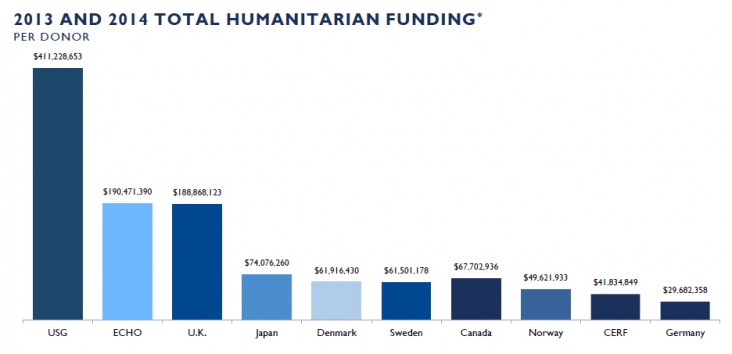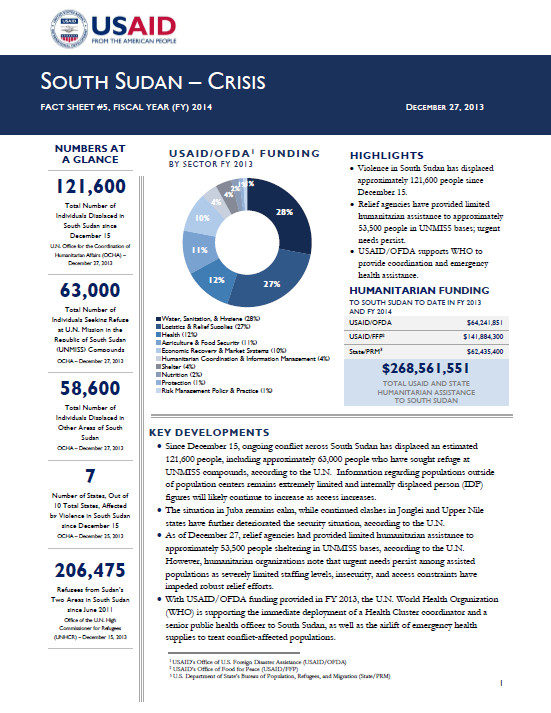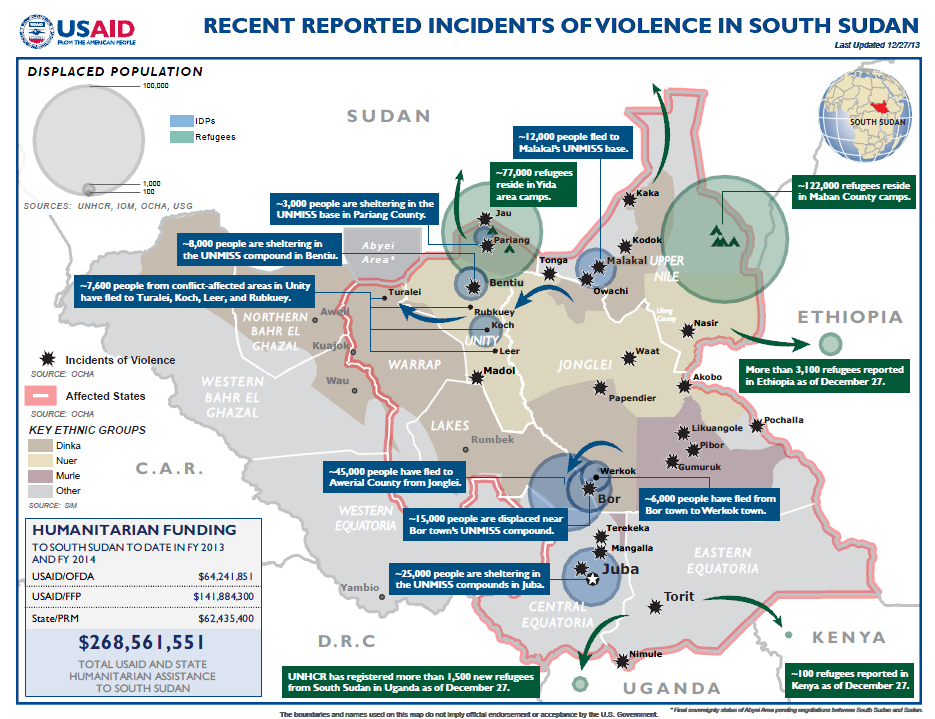- What We Do
- Agriculture and Food Security
- Democracy, Human Rights and Governance
- Economic Growth and Trade
- Education
- Environment and Global Climate Change
- Gender Equality and Women's Empowerment
- Global Health
- Humanitarian Assistance
- Transformation at USAID
- Water and Sanitation
- Working in Crises and Conflict
- U.S. Global Development Lab
Speeches Shim
March 21, 2014
Numbers At A Glance
708,900
67,400
641,500
249,000
234,500
Humanitarian Funding:
To South Sudan To Date In FY2013 and FY2014:
| USAID/OFDA | $87,174,812 |
| USAID/FFP | $141,884,300 |
| State/PRMDoD | $94,735,400 |
| TOTAL | $323,794,512 |
Highlights
Threats, harassment, and attacks targeting humanitarian actors continue to hinder the delivery of emergency humanitarian assistance.
WFP airdrops food rations for approximately 8,000 people in Unity State.
Efforts to reduce overcrowding in UNMISS internally displaced person (IDP) sites remain paramount as rainy season advances.
KEY DEVELOPMENTS
Violence and resultant insecurity continue to displace populations in South Sudan, with nearly 958,000 people—including 708,900 IDPs and 249,000 refugees —having fled since December 15, according to the U.N.
Humanitarian agencies remain concerned about the persistent threats, harassment, and attacks targeting relief actors. Checkpoints, illegal taxes, and other access-related challenges continue to hinder the transportation and distribution of much-needed relief supplies to vulnerable populations throughout South Sudan.
Relief organizations plan to construct additional displacement sites near the UNMISS compounds in Bentiu town, Unity State; Bor town, Jonglei State; and Malakal town, Upper Nile State, to improve living conditions for thousands of IDPs sheltering in overcrowded UNMISS bases. Humanitarian actors remain concerned regarding the advance of the April-to-August rainy season, as heavy rains and flooding are likely to damage shelters and latrines and increase the risk of waterborne diseases, such as malaria.
On March 19, the emergency directors of eight key humanitarian agencies arrived in South Sudan for a three-day visit to assess the current humanitarian situation and response activities, as well as increase awareness of the crisis.
INSECURITY, DISPLACEMENT, AND ACCESS CONSTRAINTS UPDATE
Ongoing hostilities continue to affect populations across South Sudan, particularly in Jonglei, Unity, and Upper Nile states, with approximately 708,900 people internally displaced and more than 249,000 additional people seeking refuge in neighboring countries, according to the U.N. While 67,400 IDPs are sheltering at several UNMISS bases in South Sudan, the majority of IDPs in the country have fled to rural areas, where humanitarian access is limited.
Insecurity continues to hamper humanitarian access and has rendered three counties completely inaccessible to humanitarians since early March—Duk County, Jonglei; Fashoda County, Upper Nile; and Leer County, Unity—according to the U.N. During the week of March 17, heavy fighting erupted again in Malakal town, Upper Nile, resulting in additional death and population displacement and forcing humanitarian partners to temporarily suspend activities.
Humanitarian actors are growing increasingly concerned regarding threats and other security incidents targeting U.N. personnel and other humanitarian workers, which continue to hinder the transport and distribution of relief commodities to populations in need, particularly those located in opposition-held areas. Armed elements have routinely halted U.N. convoys transporting food commodities, essential medicines, and other relief items, according to international media.
Illegal taxes and increased checkpoints along major roads in South Sudan, including in Warrap, Western Bahr el Ghazal, and Western Equatoria states, have increased the cost of road transportation and forced relief agencies to rely on costly air assets. On March 6, a U.N. demining specialist in Yei town, Central Equatoria State, was reportedly searched, robbed, and beaten at an SPLA checkpoint, according to international media.
South Sudan Crisis Fact Sheet #34 March 21, 2014 ![]() (pdf - 302k)
(pdf - 302k)
South Sudan Crisis Map March 21, 2014 ![]() (pdf - 960k)
(pdf - 960k)
HUMANITARIAN NEED ASSESSMENTS AND RESPONSE ACTIVITIES
Relief agencies continue to provide limited emergency assistance—including food commodities, health care services, and protection, shelter, and water, sanitation, and hygiene (WASH) support—to vulnerable populations across conflict-affected areas in South Sudan. As of March 13, humanitarian organizations had reached nearly 590,000 with some form of assistance, according to the U.N. Despite progress, humanitarian actors remain unable to fully meet the needs of assisted populations, due to persistent insecurity and inadequate sustained, predictable access, according to the U.N.
Between March 7 and 10, relief organizations, including representatives from the U.N. Food and Agriculture Organization (FAO), the U.N. World Food Program (WFP), Norwegian People’s Aid, and World Vision, conducted an inter-agency assessment in Nyal and Ganyiel payams, Panyijiar County, Unity. The assessment team identified urgent humanitarian needs for approximately 39,000 IDPs, the majority of whom fled from fighting in Unity’s Bentiu, Koch, Leer, and Mayendit counties. According to the assessment, food security conditions in Panyijiar are deteriorating due to ongoing hostilities, the large influx of IDPs, and inadequate access to food. IDPs and the host community, which has absorbed the majority of those displaced, have resorted to negative coping strategies, such as skipping meals and consuming seeds. Additional needs include improved WASH conditions, nutrition assistance, medical supplies, and other relief items.
On March 15, three USAID Disaster Assistance Response Team (DART) members visited the Tong Ping and U.N. House 3 UNMISS bases in Juba, which collectively host approximately 32,000 people, to assess living conditions and monitor construction progress at the new IDP extension site adjacent to U.N. House 3. According to relief agencies, flooding at the Tong Ping displacement site in mid-March damaged at least 150 latrines, resulting in inadequate access to sanitation facilities. In response, WASH agencies plan to begin constructing additional latrines in the coming days.
CAMP COORDINATION AND CAMP MANAGEMENT
The Camp Coordination and Camp Management Cluster—the coordinating body for humanitarian camp coordination and management activities, comprising U.N. agencies, non-governmental organizations (NGOs), and other stakeholders—continues to coordinate assistance to improve the living conditions of IDPs in South Sudan. The Cluster is prioritizing the preparation of displacement sites at UNMISS bases over open IDP sites and is working to decongest the UNMISS compounds before the onset of the April-to-August rainy season. Cluster partners plan to construct additional displacement near the UNMISS compounds in Bentiu, Bor, and Malakal; however, lack of adequate supplies, funding, and humanitarian personnel hinders progress. As of March 20, the Cluster had provided camp management services to approximately 244,000 people—56 percent of the planned 433,500 beneficiaries the Cluster plans to reach by June.
Since March 7, living conditions have deteriorated at the UNMISS Tong Ping site due to heavy rainfall in Juba, with flooding affecting nearly 20 percent of the area allocated for IDPs, according to Médecins Sans Frontières (MSF). The organization temporarily suspended medical consultations when its clinic in Tong Ping flooded in mid-March. Despite challenges, relief organizations are attempting to prevent additional flooding in the displacement sites. Since February 4, UNMISS has completed 1,800 meters of drainage work at the Tong Ping compound.
Efforts to mitigate overcrowding at Tong Ping and U.N. House 3 displacement sites in Juba continue. Between March 12 and 18, approximately 400 IDPs agreed to relocate from Tong Ping to U.N. House 3, according to UNMISS. The Agency for Technical Cooperation and Development (ACTED) and USAID/OFDA partner the International Organization for Migration (IOM) are providing safe transport for IDPs, while UNMISS troops are providing force protection for the convoys.
FOOD SECURITY AND LIVELIHOODS
The USAID-funded Famine Early Warning Systems Network (FEWS NET) reports that insecurity in South Sudan will likely affect the May-to-June cultivation season, particularly in Jonglei, Unity, and Upper Nile. Since December, hostilities have disrupted markets in Bentiu, Bor, and Malakal, displaced residents and traders, and severely constrained food availability.
As of March 20, relief agencies had reached approximately 461,200 people in conflict-affected states with emergency food commodities, with the majority of people reached residing in Lakes State, according to the U.N.
Relief agencies continue to deliver emergency livelihood supplies—including seeds, tools, and fishing kits—to vulnerable households. To date, partners have distributed livelihood assistance to more than 7,200 families in Central Equatoria and Warrap states.
HEALTH
Since December 15, the Health Cluster has reached nearly 590,000 people in conflict-affected areas—nearly 31 percent of the target population—with critical health care services, including emergency medical and trauma care, measles and polio vaccinations, and primary and reproductive health care.
The Health Cluster reports the increasing incidence of diarrhea, as well as communicable diseases, such as measles and malaria, in IDP sites across South Sudan. In response, relief agencies continue to administer oral cholera vaccinations in Awerial County, Lakes State, and the UNMISS Tong Ping IDP site in Juba. Health Cluster partners and the RSS Ministry of Health (MoH) plan to launch a combined measles and polio vaccination campaign in April, according to the U.N.
The Health Cluster is increasingly concerned about the lack of adequate shelter for IDPs in Mingkaman town, Lakes, noting that insufficient shelter increases the risk of malaria and upper respiratory infections. The majority of the approximately 74,000 IDPs that have fled to Mingkaman are living under trees and in makeshift shelters. While relief agencies have identified land for three IDP settlements, site preparation has not begun due to lack of funding.
The U.N. World Health Organization (WHO) has mobilized a mental health specialist to strengthen psychological support mechanisms and response activities for people affected by violence and provide technical support to the RSS MoH, according to the U.N.
On March 13, international NGO Medair opened a nutrition stabilization center in Ganyiel town, Unity.
LOGISTICS AND RELIEF COMMODITIES
During the week of March 17, the Logistics Cluster facilitated the airlift of 26 metric tons (MT) of relief supplies to Jonglei and Upper Nile on behalf of six humanitarian organizations, the U.N. reports. USAID/FFP partner WFP deployed food assistance to reach at least 23,000 IDPs in Ganyiel town, Unity.
USAID/FFP partner WFP has begun delivering urgently needed food commodities via airdrop operations for conflict-affected, IDP, and refugee populations in remote, access-constrained areas of South Sudan. In recent days, WFP began trial runs of airdrops to refugee camps in Maban County, Upper Nile, and delivered 15-day food rations for 8,000 people in Ganyiel town, Unity. Mobile WFP teams are registering populations for assistance and gathering and distributing airdropped food supplies. While airdrops and airlifts are costly, WFP is delivering more food commodities using these methods than initially planned due to increased access constraints, and is planning additional airdrop operations for nine locations in Jonglei, Unity, and Upper Nile.
PROTECTION
Since January 2014, the UNMISS Child Protection Unit has led weekly awareness campaigns on the prevention of child recruitment into armed groups at UNMISS IDP sites in Juba. The UNMISS Child Protection Unit is also documenting violations of children’s rights, including abduction, forced recruitment, killing and maiming, sexual exploitation, and denial of assistance. Findings will be shared with the U.N. Office of the Special Representative of the Secretary-General for Children and Armed Conflict.
WASH
Relief organizations continue to provide WASH assistance to vulnerable populations, with WASH Cluster partners reaching approximately 247,000 people across more than 20 displacement sites, according to the U.N. At the UNMISS Tong Ping site, humanitarian actors are providing 15 liters of safe drinking water per person per day to approximately 7,100 people, the International Federation of Red Cross and Red Crescent Societies reports.
On March 18, local authorities began operating a water piping system constructed by the U.N. in Yirol County, Lakes. The new system will provide approximately 30,000 people with improved access to safe drinking water.
OTHER HUMANITARIAN ASSISTANCE
To date, international donors have provided approximately $301 million—nearly 24 percent of the $1.27 billion total requested funding—to support humanitarian activities through the South Sudan Crisis Response Plan.
On March 14, the Government of Japan announced it would provide $2.5 million to the U.N. Mine Action Service in South Sudan to support the clearance of unexploded ordnance and other explosive remnants of conflict that are currently hindering relief organizations’ capacity to transport and distribute humanitarian relief commodities.

*Funding figures are as of March 7, 2014. All international figures are according to OCHA’s Financial Tracking Service (FTS) and based on international commitments during the 2013 and 2014 calendar years. USG figures are according to the USG and reflect the most recent USG commitments based on the 2013 fiscal year, which began on October 1, 2012, and ended September 30, 2013, as well as the 2014 fiscal year, which began on October 1, 2013.



Comment
Make a general inquiry or suggest an improvement.